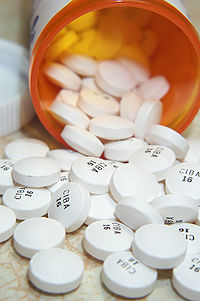
Photo from wikipedia
Background: Difficulty using the upper-limb is a major barrier to independence for many patients post-stroke or brain injury. High dose rehabilitation can result in clinically significant improvements in function even… Click to show full abstract
Background: Difficulty using the upper-limb is a major barrier to independence for many patients post-stroke or brain injury. High dose rehabilitation can result in clinically significant improvements in function even years after the incident; however, there is still high variability in patient responsiveness to such interventions that cannot be explained by age, sex, or time since stroke. Methods: This retrospective study investigated whether patients prescribed certain classes of central nervous system-acting drugs—γ-aminobutyric acid (GABA) agonists, antiepileptics, and antidepressants—differed in their outcomes on the three-week intensive Queen Square Upper-Limb program. For 277 stroke or brain injury patients (167 male, median age 52 years (IQR: 21), median time since incident 20 months (IQR: 26)) upper-limb impairment and activity was assessed at admission to the program and at six months post-discharge, using the upper limb component of the Fugl-Meyer, Action Research Arm Test, and Chedoke Arm and Hand Activity Inventory. Drug prescriptions were obtained from primary care physicians at referral. Specification curve analysis was used to protect against selective reporting results and add robustness to the conclusions of this retrospective study. Results: Patients with GABA agonist prescriptions had significantly worse upper-limb scores at admission but no evidence for a significant difference in program-induced improvements was found. Additionally, no evidence of significant differences in patients with or without antiepileptic drug prescriptions on either admission to, or improvement on, the program was found in this study. Although no evidence was found for differences in admission scores, patients with antidepressant prescriptions experienced reduced improvement in upper-limb function, even when accounting for anxiety and depression scores. Conclusions: These results demonstrate that, when prescribed typically, there was no evidence that patients prescribed GABA agonists performed worse on this high-intensity rehabilitation program. Patients prescribed antidepressants, however, performed poorer than expected on the Queen Square Upper-Limb rehabilitation program. While the reasons for these differences are unclear, identifying these patients prior to admission may allow for better accommodation of differences in their rehabilitation needs.
Journal Title: International Journal of Stroke
Year Published: 2021
Link to full text (if available)
Share on Social Media: Sign Up to like & get
recommendations!